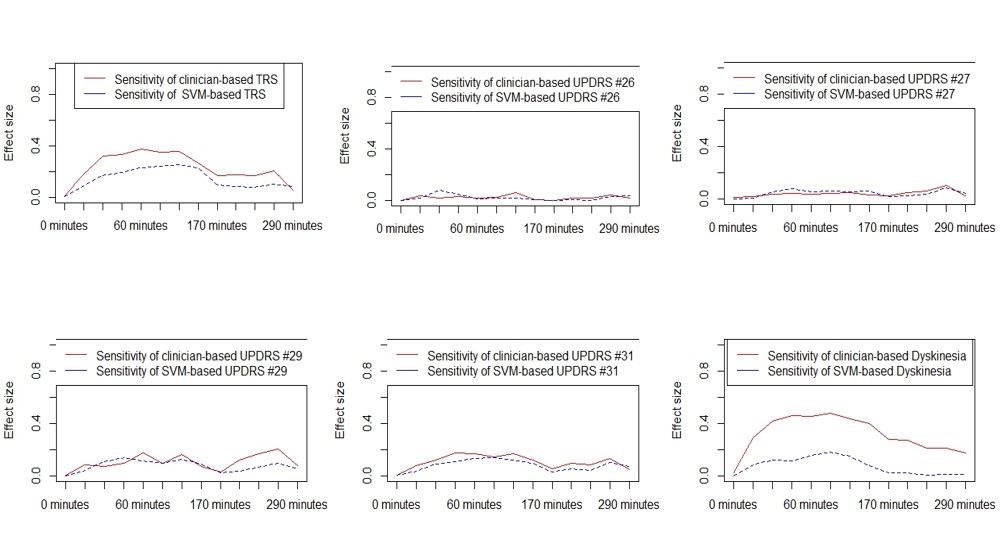Session Information
Date: Sunday, October 7, 2018
Session Title: Technology
Session Time: 1:45pm-3:15pm
Location: Hall 3FG
Objective: To develop and evaluate machine learning methods for assessment of Parkinson’s disease (PD) motor symptoms using leg agility (LA) data collected with motion sensors during a single dose experiment.
Background: Nineteen advanced PD patients (Gender: 14 males and 5 females, mean age: 71.4, mean years with PD: 9.7, mean years with levodopa: 9.5) were recruited in a single center, open label, single dose clinical trial in Sweden [1].
Methods: The patients performed up to 15 LA tasks while wearing motions sensors on their foot ankle. They performed tests at pre-defined time points starting from baseline, at the time they received a morning dose (150% of their levodopa equivalent morning dose), and at follow-up time points until the medication wore off. The patients were video recorded while performing the motor tasks. and three movement disorder experts rated the observed motor symptoms using 4 items from the Unified PD Rating Scale (UPDRS) motor section including UPDRS #26 (leg agility), UPDRS #27 (Arising from chair), UPDRS #29 (Gait), UPDRS #31 (Body Bradykinesia and Hypokinesia), and dyskinesia scale. In addition, they rated the overall mobility of the patients using Treatment Response Scale (TRS), ranging from -3 (very off) to 3 (very dyskinetic). Sensors data were processed and their quantitative measures were used to develop machine learning methods, which mapped them to the mean ratings of the three raters. The quality of measurements of the machine learning methods was assessed by convergence validity, test-retest reliability and sensitivity to treatment.
Results: Results from the 10-fold cross validation showed good convergent validity of the machine learning methods (Support Vector Machines, SVM) with correlation coefficients of 0.81 for TRS, 0.78 for UPDRS #26, 0.69 for UPDRS #27, 0.78 for UPDRS #29, 0.83 for UPDRS #31, and 0.67 for dyskinesia scale (P<0.001). There were good correlations between scores produced by the methods during the first (baseline) and second tests with coefficients ranging from 0.58 to 0.96, indicating good test-retest reliability. The machine learning methods had lower sensitivity than mean clinical ratings (Figure. 1).
Conclusions: The presented methodology was able to assess motor symptoms in PD well, comparable to movement disorder experts. The leg agility test did not reflect treatment related changes.
References: [1] M. Senek, S. M. Aquilonius, H. Askmark, F. Bergquist, R. Constantinescu, A. Ericsson, et al., “Levodopa/carbidopa microtablets in Parkinson’s disease: a study of pharmacokinetics and blinded motor assessment,” Eur J Clin Pharmacol, Jan 18 2017. [2] C. G. Goetz, G. T. Stebbins, K. A. Chung, R. A. Hauser, J. M. Miyasaki, A. P. Nicholas, et al., “Which dyskinesia scale best detects treatment response?,” Mov Disord, vol. 28, pp. 341-6, Mar 2013.
To cite this abstract in AMA style:
S. Aghanavesi, M. Memedi, M. Senek, D. Nyholm, F. Bergquist. Objective assessment of Parkinson’s disease motor symptoms during leg agility test using motion sensors [abstract]. Mov Disord. 2018; 33 (suppl 2). https://www.mdsabstracts.org/abstract/objective-assessment-of-parkinsons-disease-motor-symptoms-during-leg-agility-test-using-motion-sensors/. Accessed April 1, 2025.« Back to 2018 International Congress
MDS Abstracts - https://www.mdsabstracts.org/abstract/objective-assessment-of-parkinsons-disease-motor-symptoms-during-leg-agility-test-using-motion-sensors/

